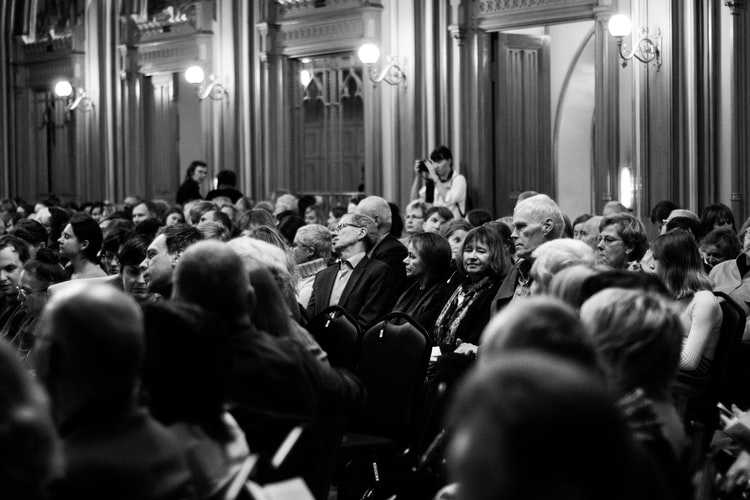
Want an actor's tool to help you become an extraordinary speaker? Here's the best way to be sure your audience stays engaged.
When it comes to influencing audiences, their engagement with your speech or presentation is all-important.
So let’s talk about how to keep an audience engaged throughout your talks. This is also about how you can make things easy for listeners while helping them retain key information.
We’re going to discuss a theatrical concept known as “beats.” It's an essential part of The Genard Method for knowing how to achieve presence and charisma as a public speaker.
Dynamic public speaking is always about connecting with your audience. Download my free resource, "Great Speaking? It's About Performance Over Content."
An Actor's Technique to Improve Public Speaking
What a “beat” is: A beat concerns a character’s intention in a scene. Think of it as the motivation that drives that character’s actions. The stronger it is, the more the actor has to “play.”
A character in a play or movie follows that motivation until either a) he or she accomplishes their objective, or b) fails to do so, for any reason. In either case, that beat gives way to a new one. It's one of the methods actors use to give them direction in a performance—the same way you need to know how to stay fully focused when speaking.
For instance, Dior Demure is a teller who is stealing money from the bank. She has a stack of bills in an envelope. In the scene, her intention (her "beat") is to keep Mr. Richley, the bank’s president, from knowing the truth.
But as she’s putting on her coat, her purse tips sideways and the envelope falls out. Mr. Richley happens to be walking by, and says, “Ms. Demure . . . what’s that?” At this point, Dior's intention to hide her theft ends, and a new intention must begin (to talk her way out of the situation, to feign ignorance of the envelope, to confess and hope to be forgiven, etc.).
How this relates to public speaking: A theatrical beat is comparable to each main point in your speech or presentation. You concern yourself with discussing each point with your audience, until you finish and begin your next main point. You may have, for instance, three main points in your presentation. Like the actor, you must make it clear that you have finished with this item, and are about to start discussing the next one.
Are you known as a great speaker? To be one, download my Free e-book, High-Impact Speaking: The Leader's Guide to Presenting with Integrity and Influence.
This is important because it allows your audience to pay maximum attention to each point you discuss. If you don’t make it obvious where the transitions are, your talk can begin to seem too long, without any places where you introduce new information.
For the audience to keep paying attention, that is, you have to give them information in bite-sized pieces. You are really “playing” each segment as you discuss it; then you give listeners a second bite, and so on. This allows everyone to hit the “refresh” button in their mind, continue to pay attention, and more easily retain what you’ve said.

How to Engage Any Audience in Your Presentations
How to “play your beats”: So how do you make this happen in your actual performance that shows you know how to captivate an audience? It’s really very easy. You only have to do two things. (You have the option of including a third action to make the transitions even stronger.) Here’s all you have to do:
- PAUSE. The more major the change between segments—for instance, between the intro and the body and between the body and the conclusion—the longer the pause should be. Between main points within the body of your talk, the pauses can be more moderate.
- DO SOMETHING DIFFERENT WITH YOUR VOICE. It doesn’t matter what, because it’s the change that refreshes listeners’ attentiveness. You can go up in pitch, down in pitch, change the quality of your voice, alter the pace at which you’re speaking, or even ask a rhetorical question: “So what should our company do to solve this problem?”
- [Optional] MOVE JUST BEFORE YOU START THE NEXT MAIN POINT. It doesn’t have to be far. If you’re standing at the end of a board table in a conference room, for example, it may involve just a couple of steps. Combined with a pause and a change of voice, moving alerts everyone visually that you’re now moving on to the next segment of your talk.
You should follow me on Twitter here.
Gary Genard is an actor, author, and expert in theater-based public speaking training. His company, Boston-based The Genard Method offers in-person and online training to help executives and teams become extraordinary communicators. In 2020 for the seventh consecutive year, Gary has been ranked by Global Gurus as one of The World's Top 30 Communication Professionals. He is the author of How to Give a Speech. His second book, Fearless Speaking, was recently named as "One of the 100 Best Confidence Books of All Time." Contact Gary here.



